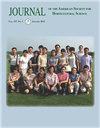Photosynthetic Pigments Profiled in Capsicum Lutescens Mutants
IF 1.1
4区 农林科学
Q3 HORTICULTURE
Journal of the American Society for Horticultural Science
Pub Date : 2021-06-08
DOI:10.21273/JASHS05025-20
引用次数: 0
Abstract
Lutescens, or lutescent, plant mutants produce leaves that are abnormally light yellow-green compared with normal plants, and are observed in multiple species of Capsicum as well as other genera such as Zea, Oryza, and Oenothera. Previous investigations into the lutescent phenotype in Capsicum have focused on genetic and transcriptomic analyses, and comparatively little is known about the phytochemical constituents of the lutescent leaf phenotype. Previous research in similar lutescent mutants in Capsicum and Oryza species has attributed their pale yellow-green leaf color and poor vigor to deficient chloroplast development. A total of 25 accessions of Capsicum lutescens mutants were phenotyped and analyzed based on a multivariate approach, using ‘Jupiter’ bell pepper (Capsicum annuum) with normal green leaves as a contextual benchmark. Photosynthetic pigments from mutant leaves were extracted and analyzed using high-performance liquid chromatography (HPLC); reflectance of the leaf material was measured with a chromameter using the L*a*b* color space. The chlorophyll a (Chl a)/b (Chl b) ratio was greater in leaves of lutescens mutants than in ‘Jupiter’. Multivariate statistical analyses revealed all lutescent mutant accessions could be distinguished from the ‘Jupiter’ contextual benchmark by variables indicating poor chloroplast development and increased photooxidative stress in lutescent mutant accessions. The lutescent leaf phenotype was not found to be caused by elevated xanthophyll or decreased chlorophyll concentrations. Furthermore, multivariate analysis revealed the lutescent mutant phenotype to be variable, with a wide range of phenotypes clustered into four major groups.辣椒突变体的光合色素分析
与正常植物相比,Lutescens或luesescent植物突变体产生的叶片异常淡黄绿色,在辣椒的多个物种以及其他属(如玉米、稻谷和油菜)中都可以观察到。以往对辣椒叶光表型的研究主要集中在遗传和转录组学分析上,而对叶光表型的植物化学成分的研究相对较少。先前对辣椒和水稻中类似的发光突变体的研究将其叶片呈浅黄绿色和活力差归因于叶绿体发育不足。以具有正常绿叶的“朱比特”甜椒(Capsicum annuum)为对照,采用多变量分析方法对25份辣椒突变体进行表型分析。利用高效液相色谱法提取突变体叶片中的光合色素;用色度计测量叶片材料的反射率,采用L*a*b*色空间。突变体叶片叶绿素a (Chl a)/b (Chl b)比值大于朱庇特。多变量统计分析显示,所有黄光突变体材料都可以通过表明叶绿体发育不良和黄光突变体材料光氧化胁迫增加的变量与“木星”上下文基准区分。黄斑叶表型不是由叶黄素升高或叶绿素浓度降低引起的。此外,多变量分析显示,光斑突变体的表型是可变的,其表型范围广泛,可分为四大类。
本文章由计算机程序翻译,如有差异,请以英文原文为准。
求助全文
约1分钟内获得全文
求助全文
来源期刊
CiteScore
3.80
自引率
0.00%
发文量
31
审稿时长
2 months
期刊介绍:
The Journal of the American Society for Horticultural Science publishes papers on the results of original research on horticultural plants and their products or directly related research areas. Its prime function is to communicate mission-oriented, fundamental research to other researchers.
The journal includes detailed reports of original research results on various aspects of horticultural science and directly related subjects such as:
- Biotechnology
- Developmental Physiology
- Environmental Stress Physiology
- Genetics and Breeding
- Photosynthesis, Sources-Sink Physiology
- Postharvest Biology
- Seed Physiology
- Postharvest Biology
- Seed Physiology
- Soil-Plant-Water Relationships
- Statistics

 求助内容:
求助内容: 应助结果提醒方式:
应助结果提醒方式:


